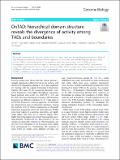| dc.contributor.author | An, Lin | |
| dc.contributor.author | Yang, Tao | |
| dc.contributor.author | Yang, Jiahao | |
| dc.contributor.author | Nubler, Johannes | |
| dc.contributor.author | Xiang, Guanjue | |
| dc.contributor.author | Hardison, Ross C | |
| dc.contributor.author | Li, Qunhua | |
| dc.contributor.author | Zhang, Yu | |
| dc.date.accessioned | 2020-07-22T18:53:36Z | |
| dc.date.available | 2020-07-22T18:53:36Z | |
| dc.date.issued | 2019-12-18 | |
| dc.date.submitted | 2019-04 | |
| dc.identifier.issn | 1474-760X | |
| dc.identifier.uri | https://hdl.handle.net/1721.1/126320 | |
| dc.description.abstract | The spatial organization of chromatin in the nucleus has been implicated in regulating gene expression. Maps of high-frequency interactions between different segments of chromatin have revealed topologically associating domains (TADs), within which most of the regulatory interactions are thought to occur. TADs are not homogeneous structural units but appear to be organized into a hierarchy. We present OnTAD, an optimized nested TAD caller from Hi-C data, to identify hierarchical TADs. OnTAD reveals new biological insights into the role of different TAD levels, boundary usage in gene regulation, the loop extrusion model, and compartmental domains. OnTAD is available at https://github.com/anlin00007/OnTAD. | en_US |
| dc.description.sponsorship | NIH (Grant R01 GM121613, R01 GM109453, R24 DK106766) | en_US |
| dc.description.sponsorship | NIH (Training Grant T32 GM102057) | en_US |
| dc.publisher | BioMed Central | en_US |
| dc.relation.isversionof | 10.1186/s13059-019-1893-y | en_US |
| dc.rights | Creative Commons Attribution | en_US |
| dc.rights.uri | https://creativecommons.org/licenses/by/4.0/ | en_US |
| dc.source | BioMed Central | en_US |
| dc.title | OnTAD: hierarchical domain structure reveals the divergence of activity among TADs and boundaries | en_US |
| dc.type | Article | en_US |
| dc.identifier.citation | An, Lin et al. "OnTAD: hierarchical domain structure reveals the divergence of activity among TADs and boundaries." Genome Biology 20 (Dec. 2019): no. 282 doi 10.1186/s13059-019-1893-y ©2019 Author(s) | en_US |
| dc.contributor.department | Massachusetts Institute of Technology. Institute for Medical Engineering & Science | en_US |
| dc.relation.journal | Genome Biology | en_US |
| dc.eprint.version | Final published version | en_US |
| dc.type.uri | http://purl.org/eprint/type/JournalArticle | en_US |
| eprint.status | http://purl.org/eprint/status/PeerReviewed | en_US |
| dc.date.updated | 2020-06-26T11:08:27Z | |
| dc.language.rfc3066 | en | |
| dc.rights.holder | The Author(s). | |
| dspace.date.submission | 2020-06-26T11:08:27Z | |
| mit.journal.volume | 20 | en_US |
| mit.license | PUBLISHER_CC | |
| mit.metadata.status | Complete | |
